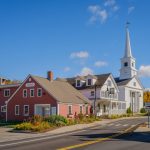Manchester, NH: Grand Re-Opening for Currier
The wind was blowing hard and cold through Manchester, New Hampshire, the first week of April when I paid a visit to the newly renovated Currier Museum of Art, now re-opened after two years of construction. The stiff wind was enough to set the curls of scrap metal atop the Currier’s new hood ornament, a […]

Coffee By Design | Portland, Maine
Photo Credit : Katherine KeenanThe wind was blowing hard and cold through Manchester, New Hampshire, the first week of April when I paid a visit to the newly renovated Currier Museum of Art, now re-opened after two years of construction. The stiff wind was enough to set the curls of scrap metal atop the Currier’s new hood ornament, a 35-foot black-and-red-steel sculpture by Mark di Suvero titled Origin, turning slowly but perceptibly, as though the kinetic abstraction somehow possessed the power to reduce the forces of nature to slow motion.
The Currier is Manchester’s mini-Met, a very fine regional museum with an important survey collection of American and European art. The $21.4 million expansion, designed by Ann Beha Architects of Boston, which also designed the New Britain Museum of American Art, adds 33,000 square feet to the Currier’s residential side street art palace, giving it now 90,000 square feet to exhibit its collection of some 11,000 objects.
The chief attraction of the renovation, however, is the wonderfully light and airy Winter Garden Cafe, which now occupies the heart of the museum, with galleries arrayed around it. The enclosed courtyard space was jammed with visitors, as was the museum proper. After two years without the Currier, Manchester seemed hungry for art, museum-goers taking advantage of free admission during opening week to check out the new design and the newly installed exhibitions.
The dramatic skylit cafe is enlivened by Wall Drawing #1255: Whirls and Twirls (Currier), a festive color square abstraction by Sol LeWitt that appears to be a sister piece to his Wall Drawing #1131: Whirls and Twirls (Wadsworth), which graces the central staircase of the Wadsworth Atheneum in Hartford. The Currier’s LeWitt, designed just before the artist’s death last year, covers the wall on either side of the grand glass entry doors to the galleries. The combination of the di Suvero sculpture on the entrance plaza and the LeWitt drawing in the Winter Garden give the Currier a lively new contemporary accent to update its classical 1929 building and eclectic collection.
It’s fun to visit a museum when the galleries are packed shoulder to shoulder with visitors, but it’s not really the best way to take a serious look at the art. Still, even distracted by the crowd and the attractiveness of the new design, I did manage to find some old friends and new acquaintances among the work on display.
I find there are two ways I tend to approach a museum visit. I can try to look at everything, which runs the risk of viewer fatigue. Or I can look selectively for works that speak directly to me. In the latter case, I either look for art that’s known to me or for art that’s new to me. Wandering through the crowds at the Currier, I found myself drawn to paintings by Rouault, Picasso, and Hartley in the modern galleries and Motherwell, Rothko, and Albers in the contemporary galleries. I didn’t really stop to look at the colorful collection of glass paperweights in the hallway gallery, but these beautiful baubles did draw a lot of admirers.
One gallery is devoted to “Celebrating New Hampshire Artists,” an exhibition that includes works by Granite Staters such as James Aponovich and Gary Haven Smith. Aponovich’s 1987 self-portrait in studio seemed a particularly apt signature piece, as the Currier sometimes seems a museum stuck in the 1980s — museum time not often coinciding with an artist’s lifetime, especially where small provincial museums are concerned.
That sense of aesthetic stop-time was reinforced by seeing Gregory Amenoff’s 1980 expressionist abstraction Down by the Pylons, Jonathan Imber’s strong 1984 self-portrait, and my old friend the late Neil Welliver’s 1980 landscape Blue Pool. Poor Neil! Even in death his methodical approach to modernizing the art of landscape paintings is misunderstood. “Paint by numbers,” one gentleman quipped as I walked by.
Among the Currier’s recent acquisitions are a bravura print by pop-art star James Rosenquist and a sculpture installation by Marisol Escobar. Rosenquist’s 1989 print House of Fire, with its arsenal of lipsticks and bag of groceries, speaks to the go-go years of the 1980s, now alas given way to the desperate years of the early 21st century. Marisol’s (she went by only her first name until recently) mordant 1963 The Family, a blocky wooden construction of father and mother with children and baby carriage, was wonderfully apropos on a day when visitors to the museum were kept busy dodging strollers.
No complaints, though. It was great to see the Currier come back to life, full of art lovers, sightseers, and the just plain curious. I made a mental note to return to Manchester in a few months when the hoopla has died down and the art can be properly seen and contemplated. Folks from out of town once again have a good reason other than cheap flights at the airport to go to Manchester.
Currier Museum of Art,150 Ash St.,Manchester, NH. 603-669-6144; www.currier.org







